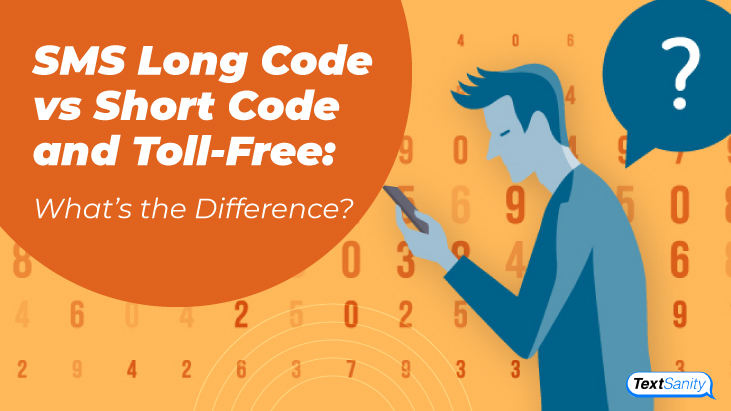SMS Long Code vs Short Code and Toll-Free: What’s the Difference?
Updated 12/07/2022
Business texting is one of the best ways for your business to build relationships. Whether you want to keep your current customer relationships strong or build new customer relationships, using a long code, toll-free, and short code phone number is the right tool for you.
When it comes to business texting, there are a few choices you’ll need to make. The first is what type of number you’re going to use for your business texting. There are three main types of business texting phone numbers: long code, toll-free, and short code.
In this post, we’ll talk about the technical and logical differences of each. And then we’ll do a quick overview of how business texting works. Sound good? Okay, let’s get started!
Business texting oversight and the TCPA
The first thing to know is that all three types of phone numbers have to comply with the same laws governing business texting. This is commonly referred to as the Telephone Consumer Protection Act, or TCPA for short. These laws are carried out by two sections of the federal government, namely the Federal Trade Commission (FTC) and the Federal Communications Commission (FCC).

Each has the ability to oversee that businesses using telecommunications, including business texting, are following the law. Arguably, the most important part of the TCPA is opt in and opt out. As such, TextSanity handles opting in and out the same way for each type of phone number. This ensures that we always adhere to the federal guidelines set forth by the TCPA.
Types of business texting phone numbers
Long code phone numbers
The first type of business texting phone number is long code. Long code phone numbers are really just regular old phone numbers. For texting purposes, they can send up to 14,000 texts at a time. For mass texting, not to be confused with group messaging, one text is 160 characters or less. So if your message is longer than that, it counts as two messages or more per text.
In the end, if you want to send a message that is 180 characters, you can only send it to 7000 recipients with this type of phone number.

Toll-free phone numbers
The second type of business texting phone number is toll-free. Toll-free numbers can send up to 44,000 texts at a time. The prefixes for toll-free numbers include 800, 888, 877, 866, 855, 844, 833, and 822.
Toll-free numbers have their drawbacks too. Since they are commonly associated with hard marketing, they are easier for customers to ignore as customers have been inundated with them for five decades. In other words, you run the risk of being background noise to customers.
Therefore, based on what you’re using business texting for, you may be better off with one of the other business texting phone number options.
Short code phone numbers
The third type of business text phone number is short code. Short codes are 5- or 6-digit phone numbers. These work great for business texting. A short code can que up to 1,400,000 texts at a time. Short code numbers need to have prior authorization from all the cell network carriers before you can use them.

In order to get prior authorization, you first need to lease a short code through the US Short Code Registry. Leasing a short code costs $500 per month if you lease a randomly generated code. If you choose to pick out a short code from the list of available codes, the cost is $1000 per month. Once you begin leasing the short code, you’ll need to submit an application to all of the network carriers.
If all of this sounds like a headache, it certainly is. That’s why TextSanity makes it easy for you to set up a short code phone number. For only $1200, TextSanity will handle the whole process for you. You will, however, still need to pay the monthly server fee for hosting your short code traffic.
The fee can vary, but most business texting providers charge around $500 per month for this service. So, as you can see short code is more convenient for customers, but a bit more of an investment for your business.
If intend to send a high volume of messages simultaneously, a dedicated short code is the solution need!
Here’s the process to get your own dedicated short code TextSanity.
1. Set up a TextSanity account.
Register an account by going to app.textsanity.com/register. Choose your plan level and a toll-free phone number. Toll-free phone numbers incur a charge of $5 per month.
2. Rent your short code through The National Short Code Registry.
The cost to rent a short code is $500-1000 a month depending on the type of code choose. Your first payment to the Short Code Registry and send your receipt to us.
3. Contact our sales team to get your application started.
When we receive your receipt for your short code, we will bill a one-time $1200 fee. Once paid, we submit an application to each of the US cellular carriers so you can send messages on your short code.
4. Connect your short code to your TextSanity account.
Once your short code is secured and applications approved, our team will connect your short code to your existing TextSanity account.
To talk to our customer service team about setting up a dedicated short code, text CONTACT to 50505 or call 877-211-4533.
Making the best choice for your business
Depending on what your business does and how it uses business texting determines which of the three business texting phone number options makes sense. For example if you are a small local business, a long code phone number that utilizes your local area code is probably your best bet.
However, if you are a large well-established business who has been using a toll-free number for years, then it’s not hard to use this number for your business texting as well. In the end, it really is up to you to decide what your business needs.

But whatever type of business texting you decide on, TextSanity is here to help. We can help you set up your business texting, chat about options, and of course, always walk you through the process. So, start using business texting and TextSanity today!


